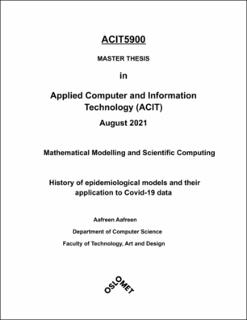| dc.description.abstract | The history of infectious diseases has always been important to us due to their impact on humanity.
Infectious diseases lead to the emergence of epidemiological models that were essential to
understand and find answers to end an epidemic. Since as early as 1760 human diseases were
analyzed using so-called epidemiological models. The main objectives of this thesis are (i) to examine
and review the history of these epidemiological models and (ii) to discuss the parameters which can
be derived from them such as the reproduction number. In particular, I focus on the SIR model to
understand qualitative features of the spread of the disease in specific cases, namely in Norway and
the UK. I implement the SIR model as proposed in the paper “Estimation of Time-Dependent
Reproduction Number for Global COVID-19 Outbreak” authors Petrova, T.; Soshnikov D.; Grunin A
[18], additionally exploring the effect of the recovery rate. Finally, I compare the results. | en_US |
